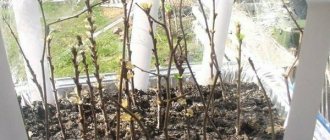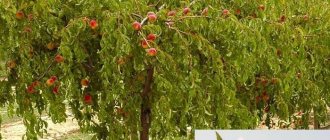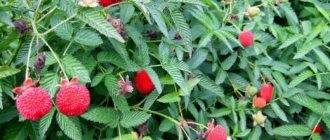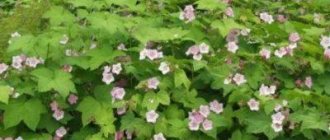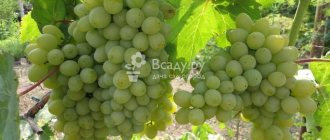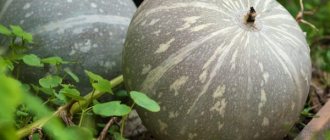Description of the raspberry variety Tarusa
The raspberry tree has erect, powerful shoots that resemble an ordinary trunk. That is, the crop is not a tree in the traditional sense of the word, but it also does not look like a bush.
The Tarusa variety has thick, elastic, straight-growing shoots without thorns. Their height is not very large (up to one and a half meters). Under the mass of berries, the shoots may bend toward the ground, so they need to be tied up. The fruits of the variety themselves are large (the weight of one berry is 7-10 g), have a bright red color and small drupes. The shape of the fruit is blunt-conical, imperfect (there are also berries that are strongly curved, with a forked fruit stem). The taste is average - most often the fruits collected from the raspberry tree are used in cooking and canned. But the berries look beautiful and they tolerate transportation and long-term storage normally.
Tarusa raspberry or raspberry tree is also called standard by breeders.
Advantages of the variety:
- Lack of thorns on leaves and stems.
- High decorative qualities and “compactness”.
- Excellent yield.
- Easy to care for.
- Large fruits.
The root system of Tarusa trees does not tend to grow throughout the area, which simplifies the care of the plantings.
Advantages and disadvantages of the plant
Now let's talk about the advantages and disadvantages of the raspberry tree. First the pros:
- High yield;
- The variety bears fruit regularly;
- High frost resistance;
- Resistance to diseases and parasites;
- Lack of thorns on the stems;
- Does not grow;
- Lack of growth;
- The berries are large;
- Good transportability.
This group of varieties has practically no disadvantages. Only the highest taste qualities can be mentioned. Therefore, the fruits are usually used for processing.
It is also worth saying that Tibetan raspberries do not tolerate high humidity well, so during prolonged rains it is necessary to ensure good drainage and moisture removal.
The right choice of seedlings for growing
The right choice of seedlings is the key to successful cultivation of raspberries of the Tagrus variety:
- buy seedlings in trusted places, preferably in specialized stores or nurseries;
- when choosing planting material on the market, ask the seller for information about the owner of the nursery, as well as documentation for the plant;
- cheap is rarely good, so don’t skimp on seedlings.
Do not buy planting material from private individuals who sit along highways and other unverified places - you risk purchasing not only low-quality, but also, for example, seedlings infected with fungus.
Landing in the ground
Before planting the plant in the ground, select a good site for these purposes. Another option is to plant tarus raspberries along the fence around the perimeter of the site.
For tarus, proximity to tomatoes, potatoes and strawberries is disastrous.
After growing a crop in one area for 8-10 years, transplant it to a new one. This land can only be used for planting tarus after 5 years.
The variety loves moisture, so provide raspberry trees with plenty of watering. The main thing is not to overwater the plant in the first weeks after planting - otherwise the shoots will simply die. It is advisable to take soil rich in useful microelements, loose - for example, sandy loam or loamy. The time to plant Tarus raspberries is spring or autumn. In the spring, this should be done as early as possible, and in the fall - in the second half of October.
Seedlings planted in the ground in spring produce a harvest only after the first year.
In winter, when the air temperature drops to -30 degrees, the stems are bent to the soil. If this is not done, the shoots will freeze and break.
Other features of planting Tarus raspberries:
- if you plan to plant several trees at once, place the holes at a distance of 50 cm from each other;
- Cover the bottom of each hole with fertilizers (for example, bird droppings or ash);
- place the seedling in the middle of the hole and immerse it strictly to the depth in which it grew in the nursery;
- Cover the hole thoroughly with earth and compact it;
- cut off the shoots - no more than 30 cm should remain above the ground;
- mulch the soil near the trunk;
- The first time after planting, water the trees generously - at the rate of 5 liters of water per bush.
During the first 2-3 days, create shade for the plants - direct rays of the sun should not fall on them.
So that Tarusa grows up on the plot
The unpretentious Tarusa raspberry still requires some attention when placed on the site, since it has its own characteristics.
Landing location
Like all raspberries, Tarusa loves places that are well lit and warmed by the sun. If several bushes are planted in a row, if possible, it is done in the north-south direction for the most favorable lighting of the plants. Some shading of Tarusa planting by nearby trees or tall shrubs is permissible only in southern areas, where the sun can be scorching.
At the same time, it is important not to miss the moment of protecting Tarusa from drafts, which she endures with difficulty. It is better to plant these raspberries near a solid fence, the wall of a building or structure.
It is also important that where the raspberry tree is located there is a fairly deep groundwater table, and there is no stagnation of moisture during snow melting, precipitation and watering. Otherwise, there is a risk of root rot and plant death.
Soil for Tarusa
Tarusa loves fertile, loose soil into which water and air easily penetrate. The area for planting raspberries is prepared a month before planting the bushes. To do this, for digging, for each linear meter of a 60-centimeter strip of soil, add:
- humus - 2 buckets;
- ash - 1 glass;
- nitroamophoska - 150 grams.
Tarusa, like other raspberry varieties, has a negative attitude towards acidic soils, since they have a low sodium and potassium content. Before planting, you need to check the acidity of the soil. To do this, you can use litmus paper, the packaging of which contains an acidity scale.
To determine the acidity of the soil, you can use litmus paper, the packaging of which provides an acidity scale
The best pH values for raspberries are from 5.8 to 6.2.
If the analysis showed that the acidity of the soil in the area is significantly higher (indicators 1–4 on the scale), to reduce this indicator, before digging up the area for raspberries, one of the following substances is added to the soil based on its acidity level per 1 m2:
- wood ash - 150–200 g;
- chalk - 500 g;
- dolomite flour - 300–1000 g.
When preparing the land for planting Tarusa and its cultivation, to ensure the required pH level, azofoska is used as a nitrogen fertilizer, and the following is excluded from the list of fertilizers:
- fresh manure;
- bird droppings;
- nitroamophoska.
Tarusa landing time
Tarusa is characterized by good survival rate of seedlings, which allows for spring and autumn planting of raspberries.
In the spring, plants can be placed in a permanent place, when the ground has warmed up enough that it is possible to form a planting hole of the required depth of 25–30 cm. Depending on the climatic zones, these are different periods, but usually March–April.
Autumn planting of Tarusa should also occur during a still warm period of the season. Depending on the climate of a particular area, this is usually done from the second half of September to October inclusive.
Features of landing Tarusa
For a separate bush, the Tarusy prepare a planting hole measuring 0.5 x 0.5 meters and, as already mentioned, 25–30 cm deep. Several raspberry bushes can be planted in a trench of the appropriate size. In both cases, the distance between plants should be at least a meter .
Just before planting the bush in a permanent place, all its shoots are cut off, leaving them about 40 cm long. The roots of the plant are straightened and placed in the hole so that the root collar, after filling the hole with soil, is at a depth of no more than 2–3 cm. Then, after the soil shrinks, it will be just at the right level.
Recent Entries
Chainsaw or electric saw - what to choose for the garden? 4 mistakes when growing tomatoes in pots that almost all housewives make Secrets of growing seedlings from the Japanese, who are very sensitive to the soil
Planted bushes are watered moderately depending on the quality of the soil; on average, 5 liters of water are consumed per bush. After absorbing moisture, the ground is covered with non-acidic peat or sawdust so that the moisture is retained at the roots longer. For the next 10–14 days, the soil is not allowed to dry out, but is moistened moderately, depending on the type of soil, so that the roots do not rot.
Tarusa feels good in one place for 8–9 years . During this period, the land is significantly depleted and the plants must be replanted in a new place, proceeding in the same way as when planting young plants. The vacated space is planted with other crops; it will be suitable for growing raspberries only after 5 years.
Taking care of Tarusa
With proper care, Tarusa raspberries produce a bountiful harvest.
For normal growth and development of Tarusa raspberries, the gardener must fully implement all agrotechnical measures:
- Feeding:
- spring feeding before bud break with urea (for every 3-4 plants prepare a solution of 50 g of fertilizer in a bucket of water) or mullein diluted in a ratio of 1:8, 4 liters of such a solution are used per bush;
- before flowering, raspberries are watered with a solution of nitroamophoska, prepared according to the instructions for the fertilizer;
- foliar feeding from the time of bud appearance is carried out once a month with a solution in 10 liters of water of 1 teaspoon of the Ryazanochka complex of microelements for berry plants or 2 tablespoons of the drug Nutrivant plus fruit;
- after harvesting, when digging up the soil of the raspberry tree, 3 kg of manure mixed with 200 g of nitroamophoska containing 5% nitrogen, potassium and phosphorus are added per 1 m2.
- Watering standard raspberries is carried out once a week, one bucket of water per plant. In wet weather, this norm is halved. It is especially important not to skip watering during the fruiting period of raspberries. However, irrigation should be correlated with the availability of natural precipitation.
- Loosening the soil and weeding. The first loosening of the soil of the raspberry tree to a depth of 10 cm is carried out in early spring, as soon as the soil allows. In the future, this operation is combined with weeding the weeds as soon as they appear, and the depth of treatment is reduced to 5 cm so as not to touch the roots of Tarusa. The last time the soil is loosened is when the raspberries have already been harvested.
- By pruning Tarusa raspberries, a bush is formed:
- The first pinching of the seedling is done when the plant reaches 160 cm. The shoot is shortened by approximately 10 cm. This stimulates the awakening of the buds in the axils of the upper leaves and the growth of lateral branches, which will be fully formed by autumn.
- In the spring of next year, the regrown side shoots are shortened by 5–10 cm, as a result, many fruitful branches are formed, on which the harvest will ripen.
- Fruit-bearing stems are cut out in the fall at the root or with a minimal stump. It is clear that to replace it, new shoots have already grown from last year’s shoots, which were already pinched in the spring, they have already formed side shoots, and after pinching next spring they will produce next year’s harvest.
- In the fall, the raspberry shoots are also pruned, leaving 6–8 of the strongest shoots, the rest are cut out completely to ground level.
The method described above for shaping Tarusa like a raspberry tree is called the double pruning method . It was developed by the famous Kurgan gardener Alexander Sobolev and tested it many times on the raspberries in his garden.
Wintering Tarusa in areas where winter temperatures do not threaten to drop below -30 ºС does not cause any problems. In those regions where such a threat is real, raspberries are lowered to the ground in September, when their stems are relatively flexible, and fixed in this position. Gardeners should not be embarrassed by leaves that have not yet fallen from the bushes.
In those regions where the threat of severe frosts is real, raspberries in September, when their stems are relatively flexible, are lowered to the ground and fixed in this position
This preparation of plants for winter is sufficient in places where there is a lot of snow. It will perfectly cover the plants and keep the buds from freezing.
If there is a possibility of a snowless winter, the planting is additionally covered with agrofibre or natural air-permeable materials (spruce branches, straw, hay, etc.).
Although Tarusa is called a raspberry tree and its trunks are powerful and quite thick, the plant is tall and bends to the ground under the load of harvest or strong gusts of wind. Therefore, to grow raspberries of this variety, it is recommended to use trellises, the schematic diagram of which is shown in the following picture.
For growing Tarusa raspberries, it is recommended to use trellises
How to care for a raspberry tree
The main task of the gardener after planting Tarus raspberries is to provide the trees with proper care:
- Water the soil - it should always be moist.
- Apply fertilizers - raspberries love chicken droppings and urea.
- Remove weeds promptly.
- In mid-summer, start pruning the shoots.
- In autumn, form bushes - remove bad shoots, cut the top to 20 cm.
- In hot weather, the soil needs to be additionally mulched.
In the first year of planting, raspberry trees need to be protected from frost by insulating the ground next to the trunk. Be sure to destroy pests promptly. As soon as the berries are ripe, remove them immediately - harvesting, starting from mid-July, is carried out on average once every two days. After rain, it is better to leave the fruits on the bushes.
If you plan to transport raspberries, collect them together with the stalk - this will extend the shelf life of the fruit.
Disease and pest control
The variety is resistant to diseases and pests. This does not mean that raspberry trees will not get sick, but even affected plants produce a good harvest. Do you need to control pests? Of course - this will help you maintain your plantings.
Let's look at the main pests of raspberry tarus:
- Aphids - attack the leaves of bushes. The easiest way to fight it is in the early stages of infection.
- Chlorosis - manifests itself in the form of yellow spots on the leaves, reduces yield.
- Raspberry beetle - eats leaves and flowers of the plant.
- Raspberry model - gnaws out buds in early spring, as a result of which the growth of raspberry tarus slows down.
- Raspberry-strawberry weevil - reproduces in buds, bites off the stalk. Because of this, the branches of the plant die and fall off. For the fight, the drug Iskra-M is used.
Do you want to protect your plantings from pest infestation? Inspect them carefully and carry out preventive treatments using special preparations. In case of severe damage to the crop, it may be easier to remove it from the site - be guided by the circumstances. In most cases, raspberry tarus bears fruit both during illness and after treatment (there may be a little less fruit, but there will be some).
Reviews from gardeners
I planted Tarusa raspberries this year. Five excellent stems have grown for next year's fruiting, about 60–70 cm, partial shade. I read that if it grows up to one and a half meters, you need to pinch out the greenery, this is less traumatic and more effective for the bush’s splendor, because its peculiarity is the appearance of the tree due to its ability to bush. So approximately, you should leave no more than 5 stems, otherwise, most likely, pollination will be worse, but maybe not))) It’s worth trying different management options, you can just observe the plant and correct it a little.
Irina Rassada
https://www.forumdacha.ru/forum/viewtopic.php?t=2174
I couldn't be happier with my Tarusa. The bushes are really bowing from the abundance of harvest. It ripens on my site around July 5th, harvesting takes about 10 days. It doesn’t leak for a very long time and is very tasty, we only keep this variety for ourselves as a late one (I wrote in the topic about remontant raspberries). I won’t say that this one is tasty and that one isn’t, it’s just that it’s different, but it’s ordinary, very fruitful (whoever wants berries, no one at the market has ever asked to try raspberries), transportable. I don’t plan to change it even in the distant future, good is not good looking for. This is me, on my site there is manure, mulch and moisture in abundance.
luganochka
https://forum.vinograd.info/showthread.php?t=3897
My Tarusa is frozen this year, perhaps due to winds with severe frosts in non-snowy areas. There was a harvest, but it was weak; the berries were large, but tasteless and forked. I haven’t decided yet - maybe I’ll delete it. I want to plant some Polish varieties.
sanjok
https://forum.vinograd.info/showthread.php?t=3897&page=4
This is my second season of Tarusa, the berry is quite large, the taste is simple but not sour, I like it, I got it from the Volkovs, the quality of the seedlings is excellent, I don’t plan to part with it yet.
Sh_333
https://forum.vinograd.info/showthread.php?t=3897&page=4
For the winter I press it to the ground with a sheet of slate. In the spring I tie it up. I like that it has good resistance to Didimella and Gallitz. Probably Tarusa and Skazka are one and the same.
michailo
https://forum.vinograd.info/showthread.php?t=3897&page=5
Tarusa raspberries are an excellent choice for novice gardeners and those who do not have a lot of time to care for more capricious crops. It is also suitable for those whose plot is located on not the most fertile soils. The simplest care will provide you with an excellent raspberry harvest, and unusual and beautiful trees will decorate the area.
- Author: Svetlana Grishkina
Good afternoon My name is Svetlana. This site has become for me not only an additional source of income, but also an opportunity to share with you my knowledge in housekeeping. Rate this article:
- 5
- 4
- 3
- 2
- 1
(3 votes, average: 5 out of 5)
Share with your friends!
Description of Tarusa raspberry
Tarusa has the following characteristics:
- Ripening period from mid-July to early August. This is a mid-season variety. Fruiting depends on the weather conditions in the region, but rarely lasts more than 15 days.
- Bush up to two meters. Tarusa is a standard variety, so the shoots are strong and do not require garter. There are no thorns. There are no side shoots in the lower half of the branches; all the berries are on top. To get a good harvest, you should leave 7–10 shoots.
- The berries are large, can weigh up to 15 g. The length of the fruit is about 5 cm. The color is bright red, there is a pronounced raspberry aroma. After picking, the berry does not release juice and can be stored for quite a long time. There is a slight sourness.
- Productivity is about 4 kg per bush.
- Excellent immunity and winter hardiness. Even an infected plant can produce a high yield.
- The crop tolerates short-term drought well. However, numerous waterings or prolonged rains can reduce yields. Also, in exceptional cases, shoots die.
Description and characteristics of the variety
You've probably heard about the so-called raspberry tree. You might think that we are really talking about a tree with a standing trunk and spreading branches on which raspberries hang like cherries or apples. This opinion is wrong. In fact, this species includes selection varieties with shoots of an erect type, so powerful that they can be mistaken for a trunk.
Among breeders, such varieties are usually called standard varieties. The term comes from the word “trunk” - a section of the trunk from the root collar to the beginning of the crown.
Standard raspberries look like a tree, not a bush
The Tarusa raspberry variety was bred by crossing the Stambovy-1 and Stolichnaya varieties by a group of breeders headed by V.V. Kichina. The first positive result was obtained in 1987, and Tarusa went on sale in 1993.
The peculiarity of the variety in question is its shoots - powerful, elastic and thick, reaching almost 2 m in length. They are perfectly straight and have no thorns on their surface. All this gives the bush a decorative appearance, so Tarusa raspberry can serve as a decoration for your site.
Although the shoots are strong, under the weight of a large number of berries they can strongly bend towards the ground. Therefore, it is recommended to tie the branches to a trellis: this will help increase productivity and protect many berries from contact with the ground and rotting.
Tarusa raspberries have large berries, weighing up to 15 g
The Tarusa variety has large, corrugated leaves of a dark green color. The red berries, shaped like a blunt cone, can reach a weight of 12–15 g, sometimes they are double. The taste is sweet without being cloying. The berries are not perfect, often distorted, but they have good transportability.
The variety is winter-hardy; it tolerates frosts down to −30 °C . But in a snowless winter with strong winds, the shoots can freeze even at −25 °C. But gardeners highlight Tarusa’s resistance to diseases and pests: even an infected bush continues to bear fruit and produce good harvests.
Video: Tarusa raspberries
Main stages of planting with photos
Proper planting determines how abundantly the crop will bear fruit, as well as how healthy the bushes will be. It is worth taking a closer look at all the nuances of planting Tarusa raspberries.
Selection of location and soil
It is necessary to carefully select a place on a summer cottage for planting this crop. Here are the rules to follow:
- the soil is loamy or sandy loam;
- availability of sufficient sun;
- planting near the fence to protect the branches from gusts of wind;
- planting where there were no raspberries or tomatoes before;
- Groundwater should not pass under this place at a depth of about one meter.
These are the basic rules that must be followed when choosing a place to plant the Tarusa variety.
Reference . If you like raspberries with high acidity, then you should choose a slightly shaded place. Then the bushes will not be able to produce enough sugar, and the fruits will have a sour taste.
Selection of seedlings
It is important to choose the right planting material, because its condition will directly affect the yield:
- It is better to buy seedlings in nurseries or specialized stores.
- Before purchasing, you should carefully inspect it to ensure there are no signs of rot or other diseases.
- It is recommended to purchase small annual shoots. They are painted green.
Step-by-step description of the process
The landing process is not complicated. Raspberries can be planted in autumn or spring. Each season has its own advantages. However, when planting material appears in the summer, it is worth preserving it until autumn. Autumn planting occurs approximately three weeks before cold weather. It is better to do this in the spring, after the weather has settled and there is no threat of frost.
Here's how this crop is planted:
- First you need to dig holes with a diameter of 60x60 cm with a distance of about 80 cm from each other. You can also use trenches. For ease of harvesting, the distance between them is about 1.5 m.
- Then humus is laid out in the ground. About 5 kg is used per bush. When using other organic fertilizers, it is recommended to lay them out so that they do not come into contact with the root system.
- Next, the raspberry bush itself is planted and lightly buried in the ground.
- Then water at the rate of 15 liters per bush.
Landing rules
In order for the plant to develop well and bear fruit consistently, it is necessary to plant it correctly. In this case, you need to choose the right place for the plant.
Terms and soils
Culture needs good lighting. Based on this requirement, it should be planted in an open area protected from drafts. Groundwater must be at least 1.5 m from the surface to prevent the root system from rotting. It is important that the soil is as fertile as possible.
Important! The plant should be placed away from tomatoes, strawberries and potatoes - these crops suffer from common pests.
Planting of the crop should be done in the spring. The temperature should be +15 degrees. It is not recommended to plant the plant in the fall, because it will begin to actively develop, which will lead to freezing of the shoots.
Landing technology
Preparation for planting work involves digging a hole. To do this, you need to make a long hole in the ground - its size should be 30 cm. If several rows of planting are planned, the row spacing should be 1.8-2 m.
How to propagate a standard variety?
The propagation process of this variety does not present any problems. If you do everything correctly, then in a couple of years you can get a fairly large raspberry garden. It is worth taking a closer look at how everything happens.
Reproduction by cuttings
This method is the best, since a sufficient amount of shoots appears. This is how this method is implemented:
- It is necessary to choose bushes with well-developed large buds.
- They need to be dug out carefully.
- From the roots you need to cut cuttings with 1 - 2 viable buds.
- Plant them in loose, nutritious soil to a depth of about 15 cm.
Method of propagation by root shoots
This method is preferable. It boils down to this:
- First, a young shoot is selected. It is advisable to use annual.
- Then it is dug out of the ground.
- After this, he is examined for signs of disease.
- Transplant the shoot where necessary.
Caring for a tree bush
It is necessary to properly care for raspberries so that they produce a good harvest. At the same time, Tarusa is considered an unpretentious variety, the care of which is quite simple.
Trimming
Pruning is carried out in spring, autumn and summer. Moreover, the most important of them is produced in the fall. In spring and summer, you only need to thin out the bushes a little. Here's how to prune raspberries:
- First you need to remove dry branches.
- Then the diseased shoots are removed. As a rule, they are increased in size or have a different color.
- Next you need to eliminate the side shoots. Leave no more than 10 on each branch.
- Before wintering, you need to trim the skeletal branches to a level of 1 m in height.
Watering
Tarusa raspberries need to be watered correctly. She is afraid of large amounts of moisture. If water remains in the soil for a long time, the root system may rot. As a result, the culture will die.
Here's how to water correctly:
- First, you should make sure that the soil is dry to a depth of about 5 cm.
- Next, you need to water the plant at the rate of 15 liters per bush.
- If the planting is of a trench type, then about 50 liters of water per square meter is required.
Top dressing
It is required to fertilize according to a certain system:
- Organic matter should be added in the spring. It is advisable to use them in liquid form.
- During the period of active growth, minerals are required. They are also added during the flowering and berry setting period.
- Before wintering, three weeks before the cold weather, you need to add organic fertilizers again. It is recommended to apply them in solid form so that they warm the root system during the winter.
Care
There are some tips for caring for Tarusa raspberries:
- After planting, you need to constantly moisten the seedling and prevent the soil from drying out. You should also not over-water, as this can lead to root rot.
- During growth, the plant needs timely watering, especially during the fruiting period, since moisture is extremely important to obtain juicy fruits.
- If the summer is hot, you will need to mulch the soil around the trunk. To do this, you can use onion or sunflower peels. Sunflower husks are expensive, so to save money, you can combine them with mowed grass. But you shouldn’t use the grass separately, as it will quickly rot.
- It is recommended to feed raspberries with fertilizers. In early spring, you can use a urea solution (50 grams per 1 bucket), this will be enough for 3-4 bushes. You can also use chicken manure. But at the end of spring, the minerals phosphorus, nitrogen and potassium (30 grams per 1 bucket) are perfect.
- Weed the plant constantly. This is necessary so that it does not become overgrown with weeds. Otherwise, the raspberries will begin to grow more slowly and will wither over time.
- If the plant suffers from mechanical damage or frost, it is recommended to spray it with a specialized solution.
- At the end of July, you can prune shoots that have already borne fruit.
- In the second half of September - the first half of October, bushes begin to form. Weakened shoots are removed, so that only strong shoots remain and their number should be about 6-7 pieces. In addition, the top of the bush is trimmed so that 15-20 centimeters remain.
- In the first year after planting, you need to insulate the seedling from frost. This can be done by covering the soil that surrounds the bush.
- To get a healthy, juicy, rich harvest, you need to promptly control pests and disease vectors.
Tips for growing a raspberry tree
You can always find various tips on growing this crop on the Internet. Here are some of them:
- In a region with cold winters, the soil should be mulched.
- It is important that raspberries have sufficient mineral and other nutrients. Otherwise, the yield will fall and the fruits will be sour.
- You can't flood the culture.
- If diseases appear, the bushes are treated with a fungicide solution, and the affected area is removed. When raspberries are attacked by pests, it is worth using industrial poisons.
These are the basic tips that new gardeners need to know.
Raspberry Tarusa
The Tarusa variety, bred by Russian breeders, is one of the most popular standard raspberry varieties, the so-called “raspberry trees”. This bush raspberry is characterized by compact shoot development, high yield and disease resistance. Tarusa bushes, consisting of a central shoot and second-order branches, are not subject to thickening, their height does not exceed 1.5 m, and there are no thorns on them, which makes harvesting and care much easier. The shoots of Tarusa raspberries are strong and elastic; under the weight of the filled berries, they bend towards the ground and can break off. True, unlike remontant varieties, Tarusa bears fruit only once a season. In the first years, little growth is formed; its quantity increases as the root system develops. Tarusa raspberries are very attractive in appearance, actually decorative, they bloom profusely and occur in early June. Ruby fruits of an elongated shape weigh on average, but the ripe harvest almost does not crumble, ripe berries have a rich raspberry aroma, but the taste is different. Tarusa's berries are sour and may even seem a little bland, but Tarusa raspberries are the best option for jam!
Harvesting
The ripening period for the crop is early July. In this case, fruiting lasts until the end of August. From 1 bush you can get 4 kg of fruit. When grown on large farms, the yield is 19-20 tons per 1 ha.
Important! Harvest should be in warm and dry weather. In this case, you need to use clean and dry containers.
If harvested correctly, raspberries can be stored for 1 week in the refrigerator. In this case, it is recommended to process the berries. You should make jam or compote from them. Fruits can also be frozen.
With balanced care, raspberries give a bountiful harvest
Tarusa raspberries are a popular garden crop with high yields. But its berries do not have a very sweet taste, so they are mainly used for canning and making desserts.
Growing conditions
Place . Plant Tarusa raspberries in a sunny place protected from strong winds. Shaded areas where trees grow are not suitable for raspberries, the only exception being hot southern regions with scorching sun. It is better to plant Tarusa raspberries around the perimeter of the site, along the fence. Neighborhood with potatoes, tomatoes and strawberries is undesirable in order to avoid transmitting their diseases to raspberries. In the first year after planting, insulate the seedlings by covering the soil around them. In the future, Tarusa will not need special preparations for wintering: at temperatures down to -25 o C, she will winter without shelter. Wrapping raspberry bushes in several layers of non-woven material, as well as bending them to the ground, will help prevent freezing in snowless and windy winters.
Prolonged rainfall is contraindicated for Tarusa raspberries - they may lose their harvest. For maximum yield, use trellises.
The soil. Tarusa raspberries need neutral or slightly acidic soils; groundwater should not be close to each other. Medium loamy and loamy soils rich in minerals are suitable. In order not to have to worry about adding soil mixture, we recommend ready-made soil PETER PEAT “Garden Soil” from the HOBBY line.
Landing. If you plan to plant raspberries in the spring, dig the soil to a depth in the fall and apply fertilizer - manure or complex mineral fertilizer. Re-dig heavy soils in the spring; for light soils, a rake is sufficient. Plant Tarusa raspberries in early spring. Before planting, mark the future rows, dig planting holes 30 cm deep for each seedling, plant the bushes often, carefully straighten the roots so that they are distributed evenly over the hole, be sure to cover the root buds with soil. Water the plantings thoroughly and mulch the surface of the soil with a layer of humus. In the first month after planting, do not allow the root system to dry out. During the planting season, loosen, water and weed regularly. Raspberries should not be overgrown with weeds, which will slow down their growth and may wither. Mulch the soil surface with humus, peat neutralized by PETER PEAT from the AGRO line or last year's sawdust.
Watering . Tarusa raspberries need moist soil - this will ensure the berries are juicy; drying out of the root system is unacceptable. But avoid overwatering the soil, which can cause root rot.
Feeding . Every year, in the spring, apply organic fertilizer to each adult Tarusa raspberry bush - a mixture of 1 bucket of humus and 100 g of urea. In summer, feed raspberries with a fermented infusion of mullein or nettle, in the fall - with a mixture of superphosphate and potassium salt.
A good fertilizer for Tarusa raspberries is nitroammofoska and any other fertilizers with phosphorus, potassium and nitrogen, as well as rotted humus and ash. For 1 sq.m you will need 150 g of nitroammophoska, or 250 g of ash, or 2 buckets of humus.
Trimming. Every year, at the end of spring, prune young shoots of Tarusa raspberries to a height of 50 cm. After pruning, the shoots will begin to intensively develop side branches, which you will also prune next spring. In cut lateral branches, shoots of the third order develop from dormant buds, on which fruit clusters develop. As a result of such pruning, Tarusa raspberries will take on the shape of a tree, its productivity will increase, supports will not be needed, and care will be simplified. From mid-September to mid-October, form a bush: remove weakened shoots, leaving; trim the top of the bush, leaving
Transplant . Once every 8 years, replant Tarusa raspberries to another site to allow the depleted soil to recover. You can return the raspberries to their original plot after 5 years.
Plant Tarusa raspberries either in the spring immediately after the soil thaws; Prepare the soil a week before planting. Do the autumn transplant in mid-October, prepare the soil a month in advance. Spring seedlings grow more slowly, the first fruits appear after a year.
Features of growing standard raspberries
Raspberries are considered an unpretentious crop, but caring for standard varieties has its own nuances. As a result of proper care and a suitable climate, Tarusa can bear fruit twice a year. A rich harvest of ripe berries from the Tarusa variety is obtained mainly in areas with dry weather. Heavy rainfall causes serious damage to the plant and can lead to its death.
How to plant
When choosing a site, you should adhere to a whole set of rules. Raspberries are planted in a place that is well lit and not shaded by houses or other buildings: the sun affects the abundance of the harvest and the sweetness of the fruit. If you place trees in the shade, the branches will begin to stretch, trying to reach the sun, the yield will drop, and the fruit will become sour. The variety can be placed around the perimeter of the garden if it is not possible to allocate a separate area. This way you will get both a decorative decoration and a hedge. You cannot plant tender berries next to potatoes, tomatoes and strawberries. Such proximity sometimes causes the development of certain diseases.
Raspberries should not be planted next to potatoes.
It is better to plant raspberries next to the apple tree. The harvest will become more abundant for both crops, and the number of diseases will decrease. Raspberries are planted so that a tall apple tree does not cast a shadow on a smaller tree.
When choosing a planting site, keep in mind that groundwater should be no higher than 1.5 m. Raspberries prefer loose soil containing useful elements - sandy and loamy soils. Sandy soil will ruin the plant due to lack of moisture, resulting in a drop in yield and smaller berries. Growing raspberries in sandy soil will only bring success if you add organic matter and clay to the soil. Sand is added to clay soil.
River sand should be added to clay soil before planting raspberries.
Before planting bushes, check the acidity of the soil. If the indicators are too high, add lime . Lime the soil in the fall if you plan to plant bushes in the spring. This is due to the loss of a large amount of nitrogen during liming. A drainage system must be installed on site.
If the acidity of the soil is increased, a liming procedure is carried out in the fall.
After 8–10 years, a new site is selected for the raspberries. This measure is necessary in order to prevent a decrease in yield due to land depletion. Raspberry bushes can be returned to their old location only after 5 years.
Tarusa is planted in spring or autumn. In spring, you need to plant the plant early. Raspberries planted at this time will begin to bear fruit only after the first season. In autumn, the tree is planted in the second half of October. You should not do this earlier, because during the warm autumn it may begin to grow and die in the winter. Often the favorable time for planting depends on the area. The optimal period is from mid-September to the end of November and from the beginning of March to the end of April .
Boarding order:
- At a distance of 50–60 cm (and it is better to retreat a meter or even one and a half, if possible), holes are dug, in each of which fertilizer is placed (for example, bird droppings or ash). If you plan to plant a whole grove, then dig a trench. The distance between rows should be 2 m.
To plant a large number of bushes, dig a trench
- When digging up the ground, remove all the excess roots so that fewer weeds will appear later. Raspberries love water, but cannot tolerate too much of it. It is recommended to plant the tree on a low embankment. The shoots occupy a large area, so the distance between the trees is large. Nutrient humus is added to the holes.
- Before planting, the root system is kept in a root growth stimulator, for example, in Kornevin.
Kornevin is used to stimulate root formation
- The young plant is placed in a hole no lower than the root collar, while maintaining the same depth at which it grew before.
- Soil is poured into the hole and compacted well.
- The shoots are cut off, leaving no more than 25–30 cm above ground level.
- The soil around the trunk is covered with mulch (humus).
- At the final stage, each bush is watered, using 5 liters of water.
- For 2–3 days, the raspberries are provided with shaded conditions, protected from direct rays of the sun.
Video: planting raspberries in autumn
Recent Entries
5 working ways to use tar in the garden 7 indoor plants that help you get married even in adulthood Indoor plants that can bloom in trouble
How to care
Periodically rid the berries of weeds. In the first year, be sure to protect from frost by insulating the soil around the trunk.
Watering
Raspberries are watered regularly, making sure that the soil is not dried out. At the same time, it is important not to overdo it: overwatering threatens to rot the root system. In dry weather, watering is done every 10 days, especially during the fruiting period. Moisture must penetrate at least 25 cm so that the entire root system is moistened. If you want to reduce the amount of watering, mulch the soil. During the hot summer, the soil around the trunk is mulched using onion peels or any other material other than sawdust. In this case, the layer is made at least 10 cm thick.
Onion peels are great as mulch.
Feeding
Tarusa is a productive variety, so increased attention is paid to fertilizers. The need for potassium is provided with the help of 300–400 grams of ash, which is added in this amount to each square meter. Ash is formed from burning wood. This fertilizer is scattered once under the tree in the spring and a little embedded in the soil. Ash contains not only potassium, but also phosphorus and other trace elements; it prevents the soil from acidifying.
Ash provides raspberries with potassium
Tarusa needs a large amount of nitrogen fertilizers. 10 grams of urea and 1 kg of manure are mixed into 10 liters of water. The resulting solution is used to water the trees, using a liter of liquid per specimen. The first time is fed at the moment the buds open, the second and third times - fourteen days later. After each application of fertilizers, the soil is watered with fresh water. Do not water only during heavy rainfall.
Tarusa also loves fertilizer consisting of an infusion of herbs with nettles. Grass and water are placed in a container (not made of metal). The mixture is infused for 7 days, then it is diluted in a ratio of 1:10 and the trees are watered at the rate of liter per specimen. During the development period, 2-3 such feedings will be enough.
Raspberries love herbal infusion with nettle as a top dressing.
During the formation of buds, Tarusa needs foliar feeding. Use complex fertilizer, for example, Ryazanochka or Kemiru-Lux. Add 1.5 teaspoons to a bucket of water. Fertilize the plant in cloudy weather (but without precipitation) during the waxing of the moon. Using a spray bottle, spray the leaves with the solution; the fertilizer should be absorbed into them by the evening.
You cannot feed with nitrogen at the end of the growing season, because it prolongs this period and promotes the growth of green mass. In this case, the raspberries will waste energy and will not be able to prepare for winter.
The tree is regularly fed with urea or chicken droppings.
Trimming
A raspberry tree will only acquire a finished appearance when it is formed correctly. The process includes timely pruning and pinching. In the first season after planting, the main shoot is pinched. The plant is pruned for the first time no earlier than the last spring month to allow the lateral buds to develop.
Pinching and pruning will help form a standard tree
Next season, the newly grown side branches are pinched. In the second half of July, the branches of the plant are pruned. In September - October, they begin to form the crown: they get rid of old branches and trim the top by 15-20 cm. If this important procedure is not given the necessary attention, the bush will not form and will not “work” at full capacity.
Preparing for winter
In areas with harsh winters, Tarusa must be prepared for wintering. The stems are gradually bent to the ground so that in winter frosts they do not freeze and die. If you leave the shoots in their original state, they will freeze and simply break. You should not cover the bushes; this will create a favorable environment for the development of parasites and the occurrence of diseases.
In winter, the bushes are gradually bent to the soil: in this position they will not freeze
Reproduction of the variety
Tarusa propagates by root cuttings or shoots. If the bush produces a small number of children, root cuttings are used. Procedure for propagation by root cuttings:
- The mother plant is undermined.
- From roots with buds, cuttings are made with two strong buds on each.
- Germination containers are filled with sand and peat.
- The cuttings are planted and the containers are placed in a warm, well-lit place.
- After rooting, the cuttings are planted.
- Next year strong seedlings will be ready.
It is much easier to propagate the plant by root shoots. The children are dug up with roots, planted in open ground, where they are watered, fertilized and mulched.
Diseases and pests
The raspberry tree is sometimes attacked by parasites and diseases, although Tarusa is resistant to attacks. In the spring, for preventive purposes, raspberries are treated with insecticides to avoid attack by pests.
The main enemy is the raspberry beetle, which eats fruits and leaves. Its reproduction is prevented by regular loosening of the soil. Beetle larvae grow in the ground, so loosening destroys the parasites. This procedure should be carried out very carefully so as not to damage the roots located near the surface. During the formation of buds, the bushes are treated with insecticides.
The main pest of raspberries, the raspberry beetle, eats fruits and leaves.
Tarusa can also be attacked by raspberry moths that gnaw out the buds in the spring. After this, the plant stops growing. They fight the parasite by cutting off diseased branches to the ground. Sometimes the tree is damaged by weevils and aphids.
Reproduction
Reproduction by root shoots. The easiest way, and the shoots can be separated throughout the summer. Carefully dig up the detached shoots, cut them off with part of the mother rhizome. Tarusa raspberries have few root shoots, and over the summer you will get only Stimulate the development of root shoots by cutting out the central shoot of the bush, and although it will not bear fruit this year, it will form a large amount of root shoots.
Reproduction by cuttings . This method will provide a large amount of planting material. Prepare cuttings in early spring: carefully dig up the bushes, select roots with well-developed large buds. From the roots, cut cuttings with viable buds. Prepare beds with loose, nutritious soil and plant the cuttings deep and water thoroughly. Make sure the soil does not dry out. The first shoots will appear on the soil surface in 2 weeks. Several times during the summer, feed the shoots with liquid humic fertilizer PETER PEAT “Living Force: for fruit and berry crops.” At the beginning of autumn or next year, in the spring, plant the young plants in a permanent place.
Reproduction of Tarusa
Propagation of Tarusa raspberries is possible in two ways:
- root cuttings;
- root shoots.
In the first case, they dig up one of the strong raspberry shoots, on the roots of which there are many dormant buds. The root is shaken off the soil and cut into cuttings 10–15 cm long and at least 2 mm thick. It is good if the cuttings have branches with additional fibrous roots. Such cuttings can be germinated in a container filled with a mixture of peat and river sand in a 1:1 ratio and placed in a warm, illuminated place. When the sprouts appear, each cutting is buried in a separate pot filled with fertile soil. This process can be practically observed in the video below.
Propagation of raspberries by root cuttings - video, part 1
Propagation of raspberries by root cuttings - video, part 2
When propagating Tarusa by root shoots, an already formed raspberry sprout with roots is separated from the root of the plant.
Scheme for separating raspberry root shoots
The soil is prepared for them, as described above for planting Tarusa, and the plants are also planted in accordance with the above description. The only difference in the process is that the seedling is not pruned, since its height is usually only 15–20 cm. Root shoots can be planted all summer long.

